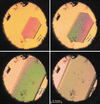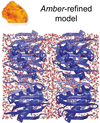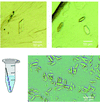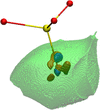issue contents
January 2022 issue

editorial
BIOLOGY | MEDICINE
The editors discuss the submission of structural biology data.
international union of crystallography
GENERAL
scientific commentaries
CRYO | EM
The 2021 Nobel Prize in Physiology or Medicine honors the discoveries of the temperature or mechanically activated channels, whose structural studies provided insights of channel gating at atomic level.
CHEMISTRY | CRYSTENG
In high-pressure structural chemistry, recrystallization techniques have been shown to be a powerful way of generating new polymorphs and solvates. A recent study by Olejniczak et al. [IUCrJ (2022), 9, 49–54] on the pyridazine-based compound 6-chloro-1,2,3,4-tetrazolo[1,5-b]pyridazine (C4H2N5Cl or CTP) uses these solvothermal techniques to establish the phase behaviour of CTP and the effects of partial hydration.
NEUTRON | SYNCHROTRON
The use of deep learning and ideas from image recognition to accelerate data analysis and hence discovery of novel materials is described. A particular focus is given to the field of energy research.
topical reviews
CHEMISTRY | CRYSTENG
A review is presented on the strategic use of scattering and imaging tools to design immunologic complexes based on porous silica for oral vaccine formulations.
research papers
MATERIALS | COMPUTATION
Mean-field theory is applied to model single-crystal diffuse scattering in molecular crystals with orientational disorder.
CHEMISTRY | CRYSTENG
Download citation


Download citation


A series of halogenated compounds with motion-capable moieties were designed and synthesized, and they exhibit different π-stacking arrangements. The thermal expansion behaviors are influenced by crystal packing, halogen-bond strength and pedal motion ability.
CHEMISTRY | CRYSTENG
Download citation


Download citation


The syntheses of regioisomers of calix[6]crown-6 under a metal carbonate template were highly metal cation-dependent and the 1,2-bridged isomer (H4L1,2) catches Cs+ very efficiently in its deep and good-fit pocket similar to a baseball glove.
CHEMISTRY | CRYSTENG
Download citation


Download citation


The ambient-pressure phase α of C4H2N5Cl transforms under 0.18 GPa to a higher-symmetry phase α′, but its high-pressure recrystallization below 0.20 GPa leads to a stochastic hydrate while above 0.20 GPa recrystallization leads to a new phase, β.
CHEMISTRY | CRYSTENG
Download citation


Download citation


With a view to establishing molecular recognition rules, the host p-tert-butylcalix[6]arene was crystallized with different guest molecules. The ratio between the apolar surface area and the volume was used to predict the formation of inclusion versus exclusion complexes, with inclusion complexes observed at ratios <40.
NEUTRON | SYNCHROTRON
Magnetic field-dependent small-angle neutron scattering is employed to analyze the mesoscale magnetic interactions in a soft magnetic HiB-NANOPERM-type alloy and relate the parameters to the experimental coercivity.
NEUTRON | SYNCHROTRON
Download citation


Download citation


High-pressure single-crystal X-ray and neutron diffraction data for copper(II) sulfate pentahydrate have been collected under precisely the same conditions, using the same sample mounted in a miniature diamond-anvil cell. The data were combined in a joint `XN' structure refinement.
CRYO | EM
findMySequence is presented – a machine-learning method for the identification of unknown proteins and sequence-assignment validation in cryo-EM and X-ray crystallography.
CRYO | EM
A comparison of atomic packing scores in protein structures determined using cryo-electron microscopy (cryo-EM) and X-ray crystallography reveals that side chains are more dispersed, indicated by lower packing scores, in cryo-EM structures compared with crystal structures.
NEUTRON | SYNCHROTRON
We propose BraggNN, a deep-learning based method, to accelerate the most computation-intensive part of polycrystal diffraction data analysis (diffraction signal characterization). The application of BraggNN for real experimental data demonstrates that it can deliver consistent (sometimes even slightly better) results compared with the conventional method while running hundreds of times faster.
BIOLOGY | MEDICINE
Based on the molecular-dynamics simulation platform Amber, a refinement algorithm has been developed to obtain structural models of protein crystals in the form of a fully hydrated unit cell. These models typically yield better Rfree values and MolProbity scores compared with the PDB-deposited or Phenix-refined coordinates. The new algorithm has a favorable radius of convergence, is simple to use and is fast.
PDB reference: type III antifreeze protein from eelpout, 7q3v
PHYSICS | FELS
The 2.22 Å crystal structure of a multi-drug exporter, CmABCB1, was determined by the LCP-SFX method using the XFEL beamline at SACLA. The lipid bilayer-embedded structure revealed new insights about the substrate transport mechanism of CmABCB1.
PDB reference: CmABCB1 in lipidic mesophase by LCP-SFX, 7fc9
NEUTRON | SYNCHROTRON
Download citation


Download citation


Experimental and theoretical charge density investigations performed for langbeinite allow for detailed examination of the redistribution of electron density under pressure both within atomic basins as well as at atomic positions.



 journal menu
journal menu




 access
access
































